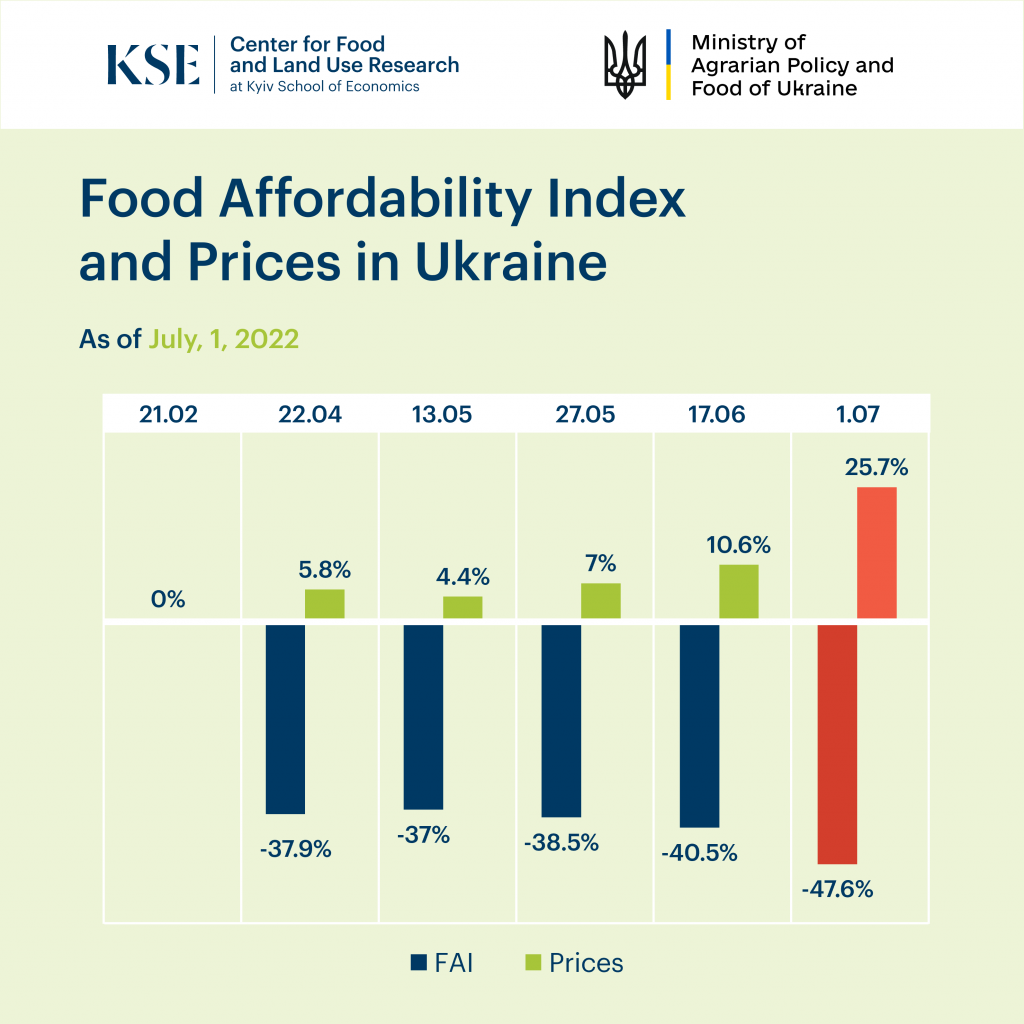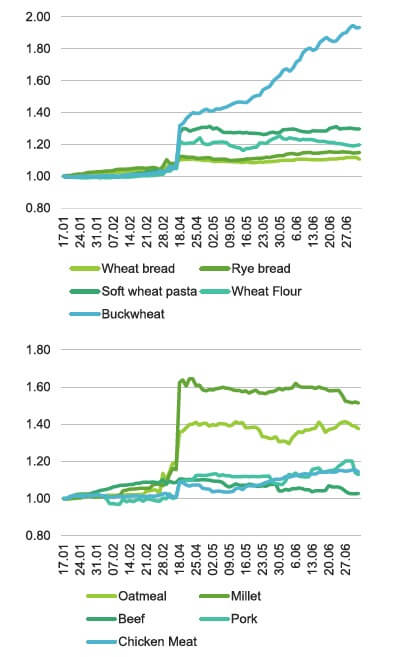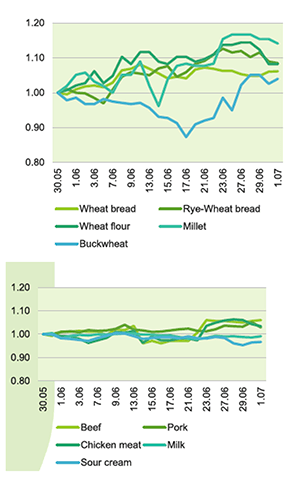- Kyiv School of Economics
- About the School
- News
- The Food affordability index in June decreased by 48% compared to the pre-war value
The Food affordability index in June decreased by 48% compared to the pre-war value
5 August 2022
By the end of June, The Food affordability index (FAI) dropped even further to 6.5, which is 47.6% lower than before the war, 12% lower than in the first half of June, and 14.9% lower than in May. Before the invasion, the FAI was 12.4. It implies that the person with an average income at the end of June could buy almost 48% less food compared with the pre-invasion level.
This is stated in the Food Security and Agricultural Policy Review – the regular monitoring of the food security situation in Ukraine and wartime agricultural policy provided by the Center for Food Research and Land Use KSE Institute (KSE Agrocenter) in cooperation with the Ministry of Agrarian Policy and Food of Ukraine.
The main reason for the worsening of FAI is the increase in the average price for the “basket of goods”. As of the last week of June (June 27 – July 1), the price of the food basket is 17.5% higher compared to the May 23-27 price. Such a dramatic increase in prices is mainly explained by seasonality. Early vegetables of the new harvest, which are much more expensive than the previous year’s harvest, started to appear in stores, leading to the increase in prices for onions (+26%), potatoes (+190%), beetroot (+51%), and carrot (+29%) as of the June 27 – July 1, compared to June 23-27.

The Russian occupation of regions where a substantial share of vegetables were produced has made this increase even more significant. The seasonal growth was increased due to the occupation of the Kherson region, which is among the leading regions in vegetable production in Ukraine. The prices continue to grow because of supply chain disruption, logistics complications, and increased production costs.
Approximately 19% of all vegetables in 2021 were produced in now-occupied territories, with this share being even higher for some vegetables – 21% for cucumbers, 31% for pepper and 32% for tomatoes.
The highest price increase is observed in Khmelnytskyi and Odesa regions: in the last week of June (June 27-June 1), compared to May 23-May 27, prices went up by 22,6% and 21%, respectively.
On June 13-17, compared to May 23-27, the highest price growth was observed for buckwheat (+16%), chicken eggs (+27%), cabbage (+21%), and onions (+14%). Commodities that experienced price decreases at the national level over this period include beef (-3%), sour cream, and butter (both -1%). On June 27 – July 1, compared to June 13-17, high price growth was observed for eggs (+25%), while there was a decrease in prices for flour (-2%), millet (-5%), and beef (-1%).
However, the team of KSE Institute’s Center for Food and Land Use Research (KSE Agrocenter), stated that at the beginning of July, positive trends in price reduction have already become noticeable.
«The prices for vegetables, which increased significantly in June, began to decrease at the beginning of July. As a result, the Food Affordability Index improved as well», – Hryhorii Stolnikovych, expert of KSE Agrocenter.

Food affordability – marginal improvement at a national level
By the end of June, as compared to the period of May 23-27, the most significant increase in the average number of assortments of food commodities available within one commodity group was observed in Rivne (+9.4%), Dnipro(+9.5%) and Chernihiv (+8.4%) regions.
The situation in Bakhmut – a city mere miles from the frontline, which was already challenging in May, did not improve throughout June. As of June 21, the average number of assortments of food products available within one product group decreased by 16,1%, as compared to May 23-27. After June 21 no data for Bakmut is available. The reason for this is the active military actions moving closer to the city and Bakhmut being one of the directions for the further RF’s offense.
Two more cities where a significant decrease in assortment was observed, are Ivano-Frankivsk (-11.4%) and Poltava (-12.2%). In other cities, no significant change was observed in June.
As of July 1, compared to May 29, availability of cabbage increased by 30.5% due to the arrival of new harvest to the stores. Also, the is an increase in the availability of millet (+14.1%) and white sugar (+13.2%). On the other hand, the availability of beetroot suffered the most significant decrease (-17.5%) due to decreased production this year – Kherson region, which is leading in beetroot production in Ukraine, is partially occupied. Beef availability, which was low in the previous periods, improved by 6%. For other categories of products, no significant changes have been observed.
Graphs below demonstrate daily changes in the number of product assortment available in Ukraine.

Agri & Land policy improving registers legislation
On June 21, amendments were made to the resolutions of the Cabinet of Ministers about registers, the holder of which is the Ministry of Agrarian Policy and Food of Ukraine. Changes affected the legislation on registries – including the registry of seed-growing entities, agronomists-inspectors registry, conformity assessment bodies registry, certificates for seeds/planting material registry, and the agrarian registry. Main changes included:
– Transfer of registries from paper to online format and creation of electronic user cabinets in order to minimize paperwork and facilitate the use of the registers.
– Assign the functions of the administrator of the registries to the state enterprise “Agrarian Registries”, which will be responsible for the deployment of the mentioned Registries.
On June 24, the procedure for using the funds provided by the state budget to support farms and other producers of agricultural products was approved.
